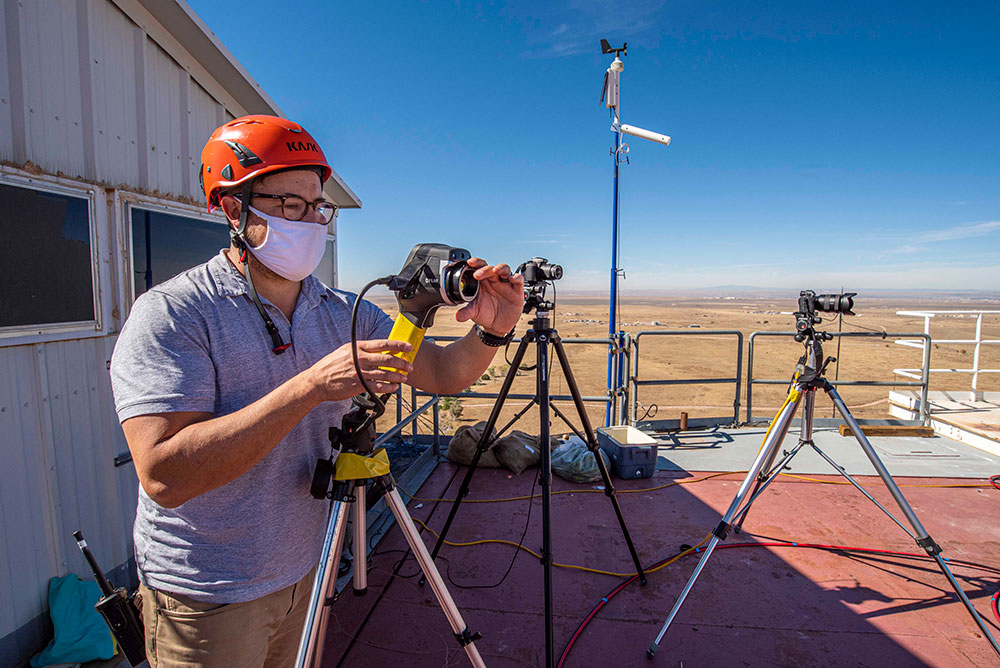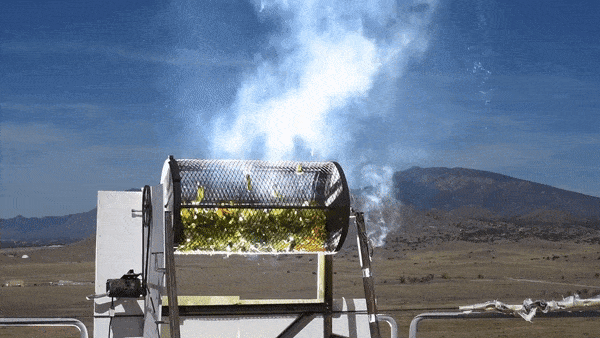Greener approach to a new Mexican staple opens up possibilities for sustainable food burning
PROBATION — From left, Sandia intern Aaron Overacker, technologist Daniel Ray and project lead Ken Armijo show solar-roasted green chili before examining chili connoisseurs for their peeling ability, taste, texture and aroma. (Photo by Randy Montoya)
By Mollie Rappe
Article courtesy of SandiaLabNews
Every August and September, the unmistakable pungent aroma of roasted green chili permeates the air in New Mexico and neighboring states.
This delicious staple of regional cuisine is green in color, but roasting the chiles to deepen the flavor and make the inedible skin easier to remove is hardly eco-friendly.
In New Mexico alone, burning propane to roast the peppers produces seasonal emissions of about 7,800 tons of carbon dioxide — the equivalent of drive 1,700 cars for a year†
Sandia engineer Ken Armijo, who grew up on a chili farm in Sabinal, located between Albuquerque and Socorro, thought there was a “greener” way to roast green chili. The results of his experiments roasting chili with concentrated sunlight will be shared at the American Society of Mechanical Engineers conference on energy sustainability this July.
“The principle behind this research was to see if high-temperature roasting of foods, not just peppers, can be done with solar energy and produce similar results to traditional propane roasting, and the answer is yes,” Ken said. “We used green chile to showcase New Mexico culture. It’s so special to combine the state-of-the-art facilities and research of Sandia National Labs with the culture, food and people of New Mexico. What other national laboratory in the world would have done this?”
Ken uses the power of the sun at Sandia’s National Solar Thermal Test Facility to explore new ways to: capture the power of the sun for electricity and industrial process heat.
Solar Roasted Green Chili

SET UP – Sandia engineer Ken Armijo sets up some infrared cameras and data collection devices before the solar chili is burned. (Photo by Randy Montoya)
For decades, Sandia has been developing technologies that convert renewable sources such as wind and sunlight into electricity and useful heat without producing greenhouse gases. Demonstrating these technologies in the real world provides valuable testing and validation. Ken’s demonstration of using solar energy to roast green chili could inspire new applications of solar technologies and new avenues of research.
With the help of several Sandia engineers, technologists and interns, Ken brought a traditional steel-drum chili burner to the top of the 60-foot tower of Sandia’s National Solar Thermal Test Facility and protected the rotor mechanism from the intense solar heat.
Ken’s father, a farmer and roaster in Chile, donated several burlap bags of green chili and his experience judging well-roasted chili. Ken’s father grows organic, heirloom chili from seed passed down through several generations.
Using 38 to 42 of the 212 heliostats — mirror-like devices used to focus sunlight — in the thermal testing facility, Ken was able to achieve temperatures of more than 900 degrees Fahrenheit evenly across the frying drum, he said. This is comparable to the temperature of a traditional propane chili burner.
He used concentrated solar energy to roast three 22-pound batches of green chile: two washed just before roasting and one dry roasted. The washed chiles took a little longer to roast than the dry chiles, but the amount of char was more uniform and the flavor profile was preferred by green chile connoisseurs, Ken said.
Then Ken’s team put the chili burner back on the ground and roasted three more batches of green chili with traditional propane. Propane was slightly faster, taking four minutes to roast washed chiles compared to six minutes for the fastest solar roasted chiles. With further experimentation and using more heliostats, Ken thinks they can roast chili even faster than with propane, but he didn’t want to scorch the chili during his initial experiments.
“With the sunburn, we were able to achieve a more uniform heat distribution,” Ken said. “When roasting on propane, you get the heat right where the burners are, but all the chili piled on it isn’t really heated as efficiently. We saw with our infrared cameras that it is more uniform with solar energy. Essentially, the heat reaches all the chili at the front of the burner. In practice, this has a lot of potential to roast chili faster, better quality and greener.”

SIZZLIN’ CHILE — Roasting green chili atop Sandia’s National Solar Thermal Test Facility. Roasting green chili with concentrated sunlight instead of propane produces flavorful chili and reduces carbon dioxide emissions. (Photo by Randy Montoya)
“Green”, green chili
For each of the traditional propane roasts, Ken noted the amount of propane used to roast 22 pounds of green chili and found that switching from propane to solar power would reduce greenhouse gas emissions by 2.68 pounds per 22 pounds of roasted green chili. If the entire state of New Mexico switched to roasting solar chili, the net result would be the equivalent of planting 130,000 tree seedlings and growing them 10 years a year.
It’s great for sustainably roasting green chili; however, if consumers don’t like the taste of solar-roasted chili, it will never be accepted. That’s where the second part of Ken’s study comes in.
Ken presented 14 green chili connoisseurs both solar-roasted chili and traditional propane-roasted chili and examined them for a variety of chili qualities. He found that on average, respondents preferred the solar-roasted chiles for flavor, 12% for fragrance, and 2% for ease of peeling off the inedible husk, on average 18%. However, the respondents preferred the texture of the propane roast at 4%.
“I conducted a survey and in general the participants preferred solar-roasted chili over propane-roasted chili,” Ken said. “That was shocking to me. They preferred the taste as it didn’t have such a burnt taste. They said it just tastes cleaner like green chili.’
From portable coffee roasters to coffee beans

ROASTIN’ TIME — Sandia engineer Ken Armijo installs a chili burner atop the solar tower over a field of mirror heliostats. Ken will present his research at an energy sustainability conference in July. (Photo by Randy Montoya)
Ken acknowledged that it’s not feasible to build a tower and field of heliostats just for roasting foods like green chili, coffee, or grains. However, he and his colleagues are investigating a much smaller and more modular solar-powered roasting system that could potentially be transported to farmers’ markets, supermarkets and chili festivals for roasting small batches of green chili, such as the propane-burning chili pepper. coffee roasters currently in use.
“My hope is that in the future chili roasters will flock to farmers’ markets and festivals with a modular mirrored roaster trailer,” said Ken. “They just pour in the chili, point the system at the sun and let it roast. That would be great.”
But Ken says sunscreen isn’t just for green chili. Concentrated sunlight can also be used to roast other foods such as soybeans at 840 degrees Fahrenheit for animal feed and human food; grains for beer at 200-400 F; almonds and cashews around 300 and 266 F; and even coffee. French roast coffee is roasted until the beans reach 464 F, and coffee beans are roasted to 350-400 F for light roast coffee. Traditionally, fossil fuels such as propane or natural gas are used for these processes.
New Mexico has practically perfect weather for sunburns, with an average of 300 days of sunshine a year, Ken said. And many other crop-producing locations also get plenty of sunny days. California’s almond-growing area gets 260 days of sunshine, especially in the summer and fall. Two California companies are even working on pilot plants to use concentrated solar energy for lower-temperature processes, such as pasteurizing almonds. Coffee farmers in Colombia, Ecuador and Peru grow and roast at high altitudes, which is also perfect for using solar energy to roast coffee, Ken added.
When it comes to the future of green solar-powered roasted foods, the sky’s the limit.
Do you appreciate the originality of CleanTechnica and the coverage of cleantech? Consider becoming one CleanTechnica member, supporter, technician or ambassador — or a patron on Patreon†


